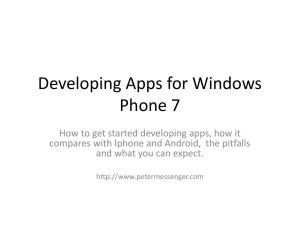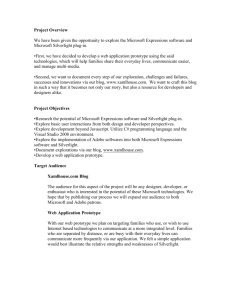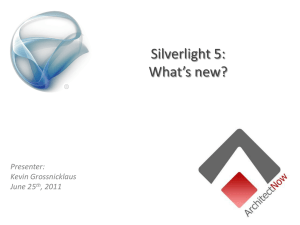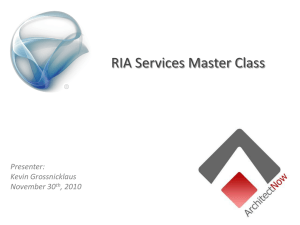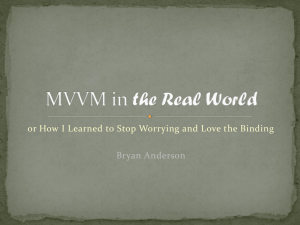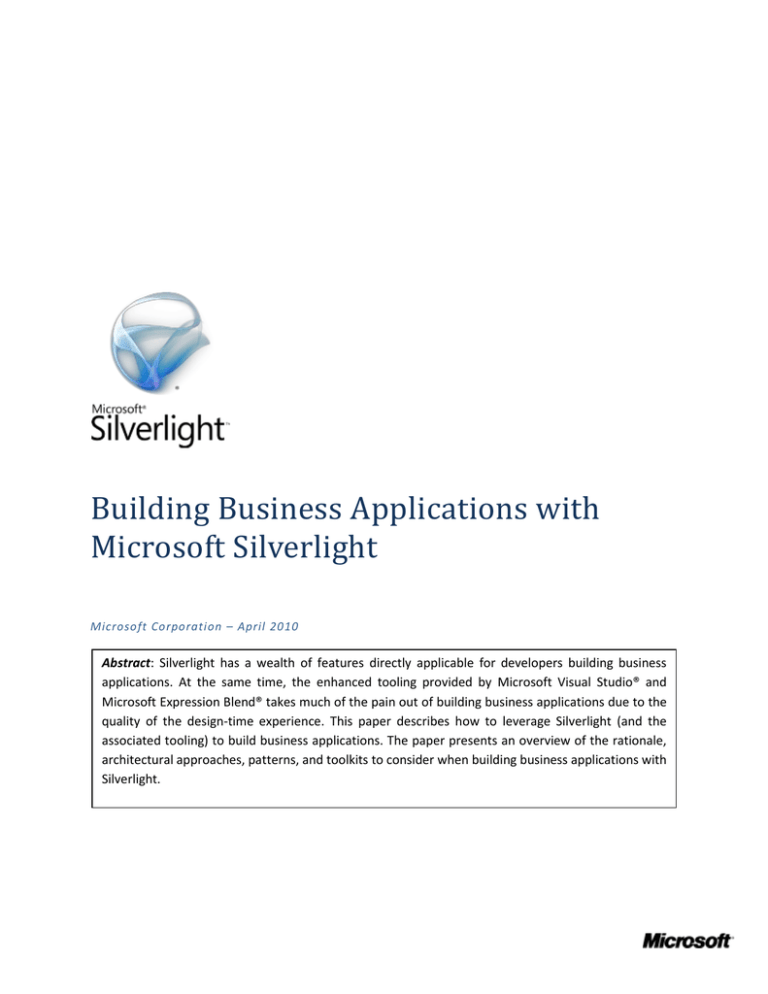
Building Business Applications with
Microsoft Silverlight
Microsoft Corporation – April 2010
Abstract: Silverlight has a wealth of features directly applicable for developers building business
applications. At the same time, the enhanced tooling provided by Microsoft Visual Studio® and
Microsoft Expression Blend® takes much of the pain out of building business applications due to the
quality of the design-time experience. This paper describes how to leverage Silverlight (and the
associated tooling) to build business applications. The paper presents an overview of the rationale,
architectural approaches, patterns, and toolkits to consider when building business applications with
Silverlight.
Contents
Introduction........................................................................................................................................................... 3
What Is a Business Application? .........................................................................................................................3
Why Consider Silverlight for Building Business Applications? ............................................................................4
Architectural Considerations ................................................................................................................................. 5
HTML / ASP.NET / PHP Application Architecture ................................................................................................5
Rich Internet Application Architecture ...............................................................................................................6
WCF RIA Services ................................................................................................................................................6
Displaying Data on the Client ................................................................................................................................. 8
Handling Large Amounts of Data .........................................................................................................9
Capturing Data on the Client.................................................................................................................................. 9
Validating User Input ........................................................................................................................................... 10
Validation Attributes ..........................................................................................................................10
Shared Custom Validation Logic .........................................................................................................10
Microsoft Extensibility Framework (MEF) ........................................................................................................11
Security Considerations ....................................................................................................................................... 12
Role Checking......................................................................................................................................12
Accessing Local Resources ................................................................................................................................... 14
Printing ................................................................................................................................................................ 15
Patterns ............................................................................................................................................................... 16
Model-View-ViewModel ...................................................................................................................................16
Dependency Injection .......................................................................................................................................17
PRISM (Composite Application Guidance for WPF and Silverlight) ..................................................................18
Conclusion ........................................................................................................................................................... 20
Additional Resources ........................................................................................................................................... 20
Silverlight Resources ...........................................................................................................................20
RIA Services Resources ........................................................................................................................20
PRISM Resources.................................................................................................................................20
MEF Resources ....................................................................................................................................20
Printing Resources ..............................................................................................................................20
Legal Notice ......................................................................................................................................................... 21
Building Business Applications with Microsoft Silverlight
Page 2
Introduction
Silverlight has rapidly evolved since its original release in 2007. The initial emphasis for Silverlight was on
providing rich media experiences, enabling designers and developers to add rich degrees of interactivity,
media and animation to their Web sites. Silverlight 3 extended the capabilities of the platform, adding
many new features essential for business application development. The rich tool support provided by
Visual Studio and Expression Blend also helps you to speed up your business application development
and lower the cost of development. Silverlight 4, the current version, adds even more features making
Silverlight a compelling choice of technology for building business applications.
What Is a Business Application?
So what do we mean by the term “business application”? A business application has a distinct purpose
or goal, and generally helps a company to save money or time, or perhaps helps them to improve
customer satisfaction. Common examples might include CRM applications, time-tracking and expense
claim applications, e-commerce and e-tail experiences, purchase request applications, and HR employee
management systems. This style of application has a number of common characteristics.
Business applications:
Are data-driven. Data is all-important, and the application needs to be able to query, shape, and
display data in different ways. The application also needs to be able to take input from the user
via form fields, validate it, and then save and update it appropriately.
Require robust data validation. To ensure the best user experience, validation of input data
needs to occur on the client with immediate feedback for the user. For added security, the
validation must also be provided on the server.
Need to be secure. The data displayed by the application typically needs to vary depending on
who is accessing the application. Authentication (in other words, knowing who is accessing the
application) is essential. Also, the functionality offered by the application often needs to vary
depending on the user’s role.
Must present a professional, efficient, and enjoyable user experience. A professional interface
that matches corporate branding requirements and enables users to get their jobs done
efficiently and effectively is generally more important than fancy visual effects. A business
application also needs to visualize data in many different ways using a variety of different
control types, ranging from simple text boxes, combo boxes, and data grids to more
sophisticated controls providing charts and reports.
Often need access to local resources. Many business applications also need access to local
resources including the local file system, other client-side business productivity applications
such as Microsoft Office Excel® or Microsoft Office Outlook®, printers, microphones, webcams,
the clipboard, and so on.
Depend on integration with external and internal services. Many business applications need to
access existing services and applications to provide critical data essential for the operation of
the business application. These may be accessed locally over the internal network or remotely
over the Internet. Access is typically via REST or SOAP calls.
Building Business Applications with Microsoft Silverlight
Page 3
Why Consider Silverlight for Building Business Applications?
Users of business applications expect rich, functional, and well-performing interfaces such as those
typically provided by the desktop applications they are used to. With the latest business applicationfocused enhancements to Silverlight, the rich capabilities of its user interface, and the associated tooling
provided by Visual Studio and Expression Studio, you can now rapidly build this type of application and
enjoy the benefits of Web delivery and deployment.
The following features in particular make Silverlight a viable and compelling technology for building
business applications:
WCF RIA Services. WCF Rich Internet Application (RIA) Services and Visual Studio 2010 provide
an elegant solution for handling the transmission of data across the tiers of your application,
data validation, and change tracking. In doing so, they provide a unified model for client-side
and server-side development, making a traditionally difficult job for the developer much easier.
Rich data controls. Silverlight provides a rich library of over sixty controls complimented by
open source and vendor control packs. The new, functionality-rich data bound controls such as
the DataGrid, ContentControl, DatePicker, and charting controls provided by the Silverlight
Toolkit make it much easier to display data in an attractive manner. New controls such as the
RichTextArea control make it much easier to capture formatted text input. Working with large
quantities of data and handling data paging is also much easier with the DataPager control,
which largely automates this job.
Page navigation. Silverlight provides a page navigation framework, making it much easier to
support navigation between pages. You can control how and when page navigation should
interact with the browser history journal, and it also provides URI mapping, enabling you to use
meaningful URIs to navigate between the different pages in your application.
Out-of-browser support. The out-of-browser feature enables your users to continue working
while disconnected from the network. For example, you could write an application that
synchronizes their changes back to the server the next time they connect. Out-of-browser
applications can also run as trusted applications with more privileges, making tasks requiring
local resource access possible. For example, you can access the local file system, interact with
Office applications, or have full keyboard access in full-screen mode.
Shared code validation. The validation feature support means you can write your validation
logic once, and have the code automatically reused in the client and on the server. You can also
declaratively apply basic validation support, such as length and range checks.
Local resource access. Silverlight enables out-of-browser Silverlight applications to access local
resources, such as the file system and clipboard, as well as other local applications and devices
that provide a COM interface. Using the COM support enables your Silverlight business
applications to integrate with Office applications such as Excel or Outlook and perform many
other tasks previously not possible from Web applications.
Printing support. Silverlight printing support enables you to print whole pages and specific data
items directly from your business applications.
Building Business Applications with Microsoft Silverlight
Page 4
Command support. Silverlight now provides support for commands in the same way that WPF
does for desktop applications. Commands provide a way to data-bind specific operations in your
application to controls in your application’s user interface. This command approach supports
patterns like Model-View-ViewModel (MVVM) that promote code separation, maintainability,
and testability.
Drag and drop. Silverlight applications can now expose drop targets, enabling users to drag files
to your Silverlight applications. For example, a user could drag and drop an Excel document onto
a Silverlight application and have the application automatically display its data in a DataGrid
control.
Right-click support. You can now create your own right-click pop-up menus to further enhance
the user experience and provide easy access to context-specific features and functions.
So, while many features essential for business applications are now available, how should you structure
your Silverlight application to best take advantage of them? How should you perform data access? How
should you pass data over the network between your rich UI and database? Establishing and
understanding the right architecture up front is essential.
Architectural Considerations
Silverlight application architecture shares much in common with traditional HTML/ASP.NET/PHP
applications, with one important difference. When you use Silverlight, the presentation logic is located
solely on the client in your user’s browser.
HTML / ASP.NET / PHP Application Architecture
Consider the architecture of a typical HTML-based Web-based application such as one you might create
using ASP.NET. This is shown in Figure 1.
Figure 1: HTML / ASP.NET / PHP Application Architecture
With this very common model, the application is divided into three tiers: presentation, business and
data. In the conventional ASP.NET/PHP model, the presentation logic on the server is responsible for
generating the necessary HTML markup, which is sent to the client’s browser to render the application’s
user interface. In many systems, the presentation and business logic, and often the data access logic, is
more closely coupled than Figure 1 would suggest, but a clear separation into distinct tiers is desirable
and offers many benefits including flexibility, maintainability, and scalability. With AJAX technology, the
Building Business Applications with Microsoft Silverlight
Page 5
richness of the user interfaces presented by this type of application has significantly increased, but
Silverlight enables you to take the richness and functionality to another level.
Rich Internet Application Architecture
The Rich Internet Application (RIA) model offered by Silverlight changes things a little by providing a
hybrid model that combines the power of Silverlight for displaying a very rich user experience (more
akin to a traditional desktop application) on the client, with the conventional three-tier Web model.
Figure 2 shows the RIA architecture.
Figure 2: Silverlight / RIA Application Architecture
Notice how the presentation tier is now completely client-side (running in the Silverlight plug-in inside
the user’s browser). In this model, the client is really an extension of the server and you should think of
the RIA as a single logical application. This raises a key question: How should you handle the
communication between client and server, across the trust boundary that is the network?
WCF RIA Services
The introduction of WCF RIA Services (hereafter called RIA Services) provides a solution to this issue, and
in doing so abstracts much of the underlying complexity of communicating across a trust boundary from
client to server. The fundamental objective for RIA Services is to provide a coherent, end-to-end view of
an application, connecting the presentation views on one side with the database on the other. This,
together with the fact that RIA service abstracts away the detail of having to deal with asynchronous
communication (something Silverlight relies upon), greatly simplifies the overall development task.
Central to the RIA Services approach is a server-side domain service class. This exposes a set of methods
callable over the network (called operations) required by the presentation logic, such as operations for
querying and returning sets of data, for updating existing data and inserting new data into the backend
data store through the data access layer.
A domain service on the server is exposed to the client-side presentation tier through the domain
context class (automatically generated from the domain service class by the Visual Studio tools when
you build your project). The RIA Services solution layered on top of the RIA application architecture is
shown in Figure 3.
Building Business Applications with Microsoft Silverlight
Page 6
Figure 3: WCF RIA Services, the domain service and domain context classes
The domain context class is responsible for providing access to the data via a series of public operations
(methods). While WCF RIA Services does not mandate which data access technology you must use, a
convenient approach is the ADO.NET Entity Framework, which enables you to program against the data
model and which takes care of the object to relational mapping for you.
NOTE: RIA Services works with any data access approach. For example, you might choose to use
NHibernate or a custom data access architecture. Regardless of the data access approach, you can still
expose your data by using RIA services.
The following code snippet shows what a typical domain service class looks like. This code is
automatically generated by Visual Studio when you add a new item of type Domain Service to your
project.
[EnableClientAccess()]
public class ProductDomainService : LinqToEntitiesDomainService<NorthwindEntities>
{
public IQueryable<Product> GetProducts()
{
return this.ObjectContext.Products;
}
public void InsertProduct(Product product)
{
if ((product.EntityState != EntityState.Added))
{
if ((product.EntityState != EntityState.Detached))
{
this.ObjectContext.ObjectStateManager.ChangeObjectState(product,
EntityState.Added);
}
else
{
this.ObjectContext.AddToProducts(product);
}
}
}
. . .
Building Business Applications with Microsoft Silverlight
Page 7
Notice how this example is using the Entity Framework for data access and as a result the domain
service class derives from the LinqToEntitiesDomainService base class. The class is also annotated with
the EnableClientAccess attribute. This defines that the domain service class should be projected to the
client and be made available via the associated domain context class. This client-side class is
automatically generated for you when you build your project inside Visual Studio.
In the above example, the domain service class has been generated from a Product entity, generated
from the Microsoft SQL Server® Northwind database. By default, any newly created domain class
exposes a set of CRUD operations, including:
A public Get method (GetProducts in this example) that returns an IQueryable interface, in this
case encapsulating a set of Product objects. You can easily add additional LINQ statements to
filter, sort, or restrict the returned product set in some way depending on your business logic
requirements.
Insert, Update, and Delete methods for performing other CRUD style operations.
You can also add your own custom methods to the domain service class. These can include custom
business logic and custom validation. For example, you may need to provide a GetProductByID method
that accepts a product ID as an input parameter and returns specific product details.
Displaying Data on the Client
The server-side domain service is presented to your Silverlight project as a domain context object. Visual
Studio automatically generates the code for the domain context class for you based on your domain
service class. The domain context class exposes a similar set of CRUD operations for the Silverlight client
to call, enabling data to be queried and retrieved, inserted, updated, and deleted against your data
source. This capability of replicating the server-side operations to the client-side Silverlight code helps to
streamline and simplify the development process.
To display the data on your Silverlight UI, you can choose from a variety of controls including TextBox,
ComboBox, ListBox, or DataGrid, all of which support data binding directly to the entities collection on
the data context. For example, the following code snippet shows how to use the domain context to
retrieve a set of data and bind it to the DataGrid control.
// Create a new domain context
var context = new ProductsDomainContext();
// Data bind the Products collection exposed by the domain context
// to the data grid control
productDataGrid.ItemsSource = context.Products;
// Load the data by calling the GetProductsQuery method
context.Load(context.GetProductsQuery());
When GetProductsQuery is called on the client-side domain context, Microsoft Windows®
Communication Foundation (WCF) service communication is used to call the equivalent domain service
Building Business Applications with Microsoft Silverlight
Page 8
operation on the Web server, retrieve the data, and load it into the client-side context, where it is
helpfully exposed via an Entity collection property.
In addition to being able to programmatically establish the connections between your data and the UI
controls, you can also use the designer support in Visual Studio by dragging controls directly from the
Data Sources window onto your design surface. This establishes all of the data bindings for you without
you needing to write any explicit code.
Handling Large Amounts of Data
If you need to handle large data sets, such as products from a product catalog, orders from a purchase
order system, or employee records from an HR system, you need to consider data paging, which is
presenting a single page of data at a time while allowing the user to perform sorting and filtering across
the entire data set.
Silverlight provides the DataPager control to greatly simplify this task. To add data paging to your
application, you can simply drag and drop the DataPager control onto your design surface, typically
beneath a DataGrid. You then bind the DataPager to the data source exposed by the domain context
and subsequent data retrieval is handled a page at a time.
Even with data paging, network latency and data processing time can cause delays. To provide a visual
cue to your users that activity is occurring, you can use the BusyIndicator control to provide feedback.
This control, along with many other data visualization controls, is available in the Silverlight Toolkit
which you can download from http://silverlight.codeplex.com.
Capturing Data on the Client
Silverlight supports controls to handle all of the common forms-based data input tasks your business
application might need. Some rich controls, including Calendar and DatePicker, enable you to quickly
construct data input forms. Using the new controls and also the new tooling provided by Visual Studio
2010 can greatly improve your development productivity and also enhance your application’s user
experience.
As an example of the productivity enhancements provided by Visual Studio 2010, you can now use
options from within the data sources window to auto-generate large chunks of your user interface
based on the data exposed by your domain context classes. The data sources window lists the domain
context classes in your application and lets you specify the type of control you’d like to use to display
each data property, such as a check box, radio button, edit box, combo box, image control, and so on.
Alternatively you can accept the defaults that Visual Studio applies. You can also decide whether or not
you want to display the data as a master list or a details view. This enables you to display tabulated lists
of data together with forms that enable you to edit and update that data.
The enhanced tooling provided by Visual Studio 2010 and Expression Blend takes much of the pain out
of building business applications due to the quality of the design-time experience.
Building Business Applications with Microsoft Silverlight
Page 9
Validating User Input
Business applications need to validate their user input in a variety of ways, ranging from simple type,
length, and range checks to more sophisticated, custom validation that depends on business rules. In a
Silverlight application (or indeed any Web application), the validation needs to occur in two places:
On the client. To provide a rich user experience and instantly present well-formatted validation
error messages to the user next to the input field containing the invalid entry.
On the server. For added security, in case a malicious user bypasses your Silverlight client
application and attempts to call your backend services directly.
Validation Attributes
RIA Services enables you to leverage types from the System.ComponentModel.DataAnnotations
namespace that you can apply directly to properties on your entity data model classes to perform
common validation checks. You add them in your server project and they are automatically propagated
at build time, to the associated client-side classes. DataAnnotations that provide property validation
include DataTypeAttribute, RangeAttribute, RegularExpressionAttribute, RequiredAttribute, and
StringLengthAttribute.
NOTE: You can use DataAnnotations with or without RIA Services.
An example is shown in the following code snippet.
[Required(ErrorMessage=”You must provide a surname”)]
[StringLength(50, ErrorMessage=”Surname cannot exceed 50 characters”)]
public string Surname
{
get { return Surname; }
set { … }
}
Shared Custom Validation Logic
For more sophisticated and custom validation logic, you can use the CustomValidationAttribute. You
can apply custom validation to a single property or to an entire entity class, enabling you to provide
entity-level validation. In order to write the custom validation code only once, yet enable the validation
logic to be applied on both the client and server sides, you add your validation class code to the Web
server project in a file with the .shared.cs or .shared.vb file extension. At build time, the shared code
is automatically propagated to the Silverlight project in order to provide the client-side validation.
For more information about Silverlight data validation, see “Data Validation with Silverlight 3 and the
DataForm” at http://msdn.microsoft.com/en-us/magazine/ee335695.aspx.
Building Business Applications with Microsoft Silverlight
Page 10
Microsoft Extensibility Framework (MEF)
Business applications, like most applications, need to evolve over time as businesses change and evolve
and new requirements for new functionality emerge. You need an effective way to enable an application
to be incrementally extended over time, without having to change the application’s existing codebase.
This is really important, because by avoiding any changes to the existing code, you do not have to worry
about introducing new bugs and having to go through a lengthy and costly retesting cycle.
The Managed Extensibility Framework (MEF), a new library in Silverlight 4, can help you to simplify the
design of extensible applications. MEF provides a way for you to assemble applications from extensions
and be able to dynamically add extensions to your application over time. This ability to plug new
functionality into your applications without having to touch the existing application’s code provides
significant benefits for application maintainability. It also enables third parties to extend your
application after it is deployed, adding new features and functionality. MEF also enables you to separate
concerns in your application, a benefit over and above extensibility.
For more information about MEF, see “Building Composable Apps in .NET 4 with the Managed
Extensibility Framework” at http://msdn.microsoft.com/en-us/magazine/ee291628.aspx.
Building Business Applications with Microsoft Silverlight
Page 11
Security Considerations
Business applications need to be protected, as they often deal with sensitive and restricted data and
functionality that should only be displayed to specific individuals or specific types of user, such as
managers. Also, for legislation compliance, you usually need to know who is accessing your data. When
building your Silverlight business applications, you have access to the ASP.NET membership and role
management system to provide authentication and authorization. Note that the ASP.NET Profile system
is also available to help you provide personalization features for your users – for example, to track user
specific preferences such as color choices or other application-specific settings.
RIA Services supports both Windows Integration authentication and Forms authentication. By using
Windows authentication, you can authenticate users with their regular Windows Active Directory
domain accounts providing a single sign-on experience for them. With Forms authentication, you
authenticate users with custom usernames and passwords maintained in a separate user store, most
often a SQL Server database.
To restrict access to your domain service and require authenticated access, you can add the
RequiresAuthentication attribute to your domain service class.
[EnableClientAccess()]
[RequiresAuthentication]
public class ProductDomainService : LinqToEntitiesDomainService<NorthwindEntities>
When a user now attempts to access your Silverlight application, an error will result when the
application attempts to call the domain service. In response to the error, you would typically display the
login dialog box. Note that the Silverlight 4 Silverlight Business Application template automatically
provides login and register dialog boxes together with a login link from the application’s home page.
Role Checking
Once authenticated, you often need to check the role membership of the authenticated user and
perform different operations depending on the type of user accessing your application. For example,
you might have some sensitive data that should only be displayed to managers.
You should restrict access to this type of sensitive data at source on the server, and not send it over the
network to unauthorized users. The following code snippet shows this approach.
[RequiresAuthentication]
[EnableClientAccess()]
public class EmployeesDomainService:LinqToEntitiesDomainService<NorthwindEntities>
{
public IQueryable<Employee> GetEmployees()
{
foreach (var e in this.ObjectContext.Employees)
{
if (!this.ServiceContext.User.IsInRole("Managers"))
{
e.Salary = null;
}
else if (e.Title.Contains("President"))
{
Building Business Applications with Microsoft Silverlight
Page 12
e.Salary = null;
}
}
return this.ObjectContext.Employees;
}
Notice how the standard data query operation on the domain context (GetEmployees in this example)
has been extended to include some additional role-checking logic that determines whether or not an
employee’s salary should be returned to the client.
NOTE: While RIA services makes your development easier, Silverlight provides some of its own
credential-based security features. These and the ASP.NET membership system can be used with or
without RIA services.
Building Business Applications with Microsoft Silverlight
Page 13
Accessing Local Resources
Many business applications require access to local resources, such as the user’s local file system, other
applications running on the user’s computer, or other devices such as webcams and microphones.
Traditionally, there has only been limited support for local resource access from Web applications, due
to the restricted sandbox with limited privileges in which Web applications run.
Silverlight 3 introduced out-of-browser applications, which a user can choose to install locally and run
directly from the Start menu or desktop. Appropriately designed out-of-browser applications can also
run offline, without requiring a connection to the Web server. Your application can use isolated storage
to store offline data, use network detection to check for a network connection, and then re-synchronize
data back to the server when a connection is available.
For security reasons, out-of-browser applications run as partial-trust applications with limited privileges.
Silverlight 4 extends the capabilities of out-of-browser applications by enabling them to run as a trusted
application with additional privileges. When installing a Silverlight 4 out-of-browser application locally,
your user is prompted about the potential risks associated with allowing this and users should be
educated to only install trusted applications from known sources.
Regular browser-based Silverlight applications can:
Access the user’s webcam. A security registration application at the reception desk of an office
building could use the webcam to take a snapshot picture of a visitor to save or print.
Access the user’s microphone. A user could add voice annotations to a set of data presented by
an application to provide feedback.
Access network resources and services in separate network domains. This is important if your
application needs to access data from other servers and services located elsewhere in your
organization.
When running as an out-of browser application, your Silverlight applications can:
Load HTML content from a Web page by using the WebBrowser control.
Display pop-up notifications near the Windows system tray.
When running as a trusted out-of-browser application, your Silverlight applications can:
Access files on the local file system, for example, to read and write local data.
Access Office applications via COM interop. For example your application could provide an
export to Excel option.
Access any other devices or applications that provide a COM interface. Many Windows functions
and capabilities are exposed by COM interfaces. Being able to make COM calls enables you to
extend your applications to leverage the full power of the Windows operating system.
Use the full keyboard while running in full-screen mode. This is important for certain types of
interface where the full screen view is needed.
Building Business Applications with Microsoft Silverlight
Page 14
Printing
Printing is a common requirement for many line-of-business applications. Silverlight now has printing
support that enables you to present print previews and to print selected parts or all of your application’s
interface or data displayed. Printing is controlled by the PrintDocument class, which exposes a number
of events that are called to ask you about how to print individual pages. Printing a document is as simple
as setting the document name (this is what shows up in the print spooler), handling events such as
StartPrint and PrintPage events, and then starting the printing process by calling the Print method of
the PrintDocument object.
The following code snippet shows the basic approach.
private void btnPrint_Click(object sender, RoutedEventArgs e)
{
PrintDocument pdoc = new PrintDocument();
pdoc.DocumentName = “Employee Listing”;
pdoc.PrintPage += (s, args) =>
{
// Assign the XAML element to be printed. This can be any UIElement-derived
// element that you need to print.
args.PageVisual = this.employeeDataGrid;
// Controls whether or not to call again for another page
e.HasMorePages = false;
};
pdoc.Print();
}
Typically, you would print an entire page or a specific control such as a DataGrid or a container for other
elements if you need to print part of a page. You need to provide a print button in your application, to
which you attach your printing code. In response to the user clicking the application’s print button, the
PrintDocument class accesses and displays the operating system specific Print dialog box, enabling your
user to choose a printer, specify print preferences, and so on before sending the data to the printer.
For more information about Silverlight printing, see http://silverlight.net/learn/videos/all/printing-apibasics/.
Building Business Applications with Microsoft Silverlight
Page 15
Patterns
There are a number of design patterns that you should consider when building your line-of-business
Silverlight applications, in order to better structure and modularize your applications and make them
inherently more testable, extensible, scalable, and maintainable. While they are not mandatory for
building Silverlight applications, patterns such as Model-View-ViewModel (MVVM) and Dependency
Injection are highly recommended.
Model-View-ViewModel
The MVVM pattern is fundamentally about the separation of concerns within your code base. For
example, MVVM enables you to separate your Views (the presentation of the application’s interface to
the user) from the data and logic. Designers can design the View in Expression Blend while the
ViewModel can be developed in Visual Studio. One of the core benefits of MVVM is that it improves the
testability of your code by moving application logic out of the View and into the ViewModel. The View is
typically difficult to test, because you need your test harness to drive the mouse and keyboard, or you
need to fall back to manual, labor-intensive tests. The ViewModel is easier to test because you can drive
it from test code. So the more you move from the View to the ViewModel, the easier the testing gets.
This also helps when it comes to debugging your code.
Your Views, view models, and Models are all separate entitles that are loosely coupled. They
communicate with one another, but only through defined interfaces.
Figure 4: Model-View-ViewModel Pattern
So how is the View different from the ViewModel and the Model?
View. The View contains the controls and behaviors that make up the user interface. It can also
contain animations, navigation aspects, themes and other interactive features used to render
the visual interface. The whole View should be defined declaratively (in XAML) where possible in
order to benefit from (for example) the Expression Blend and Visual Studio designer support.
The View also contains the declarative bindings (again in the XAML) that identify the data items
that will be presented to the user. The bindings point to the names of the data item properties,
but do not have awareness of where those properties are nor where they come from. You
should keep the code in the View and its code behind file to a minimum.
Building Business Applications with Microsoft Silverlight
Page 16
ViewModel. The ViewModel represents the data for the View, and handles the communication
between View and Model through bindings. It contains no user interface elements, but drives
the Model, and provides the entry points into the hierarchies of data. It can also shape and
combine the data in different ways so that the View can bind to it. ViewModel classes typically
support the INotifyPropertyChanged and INotifyCollectionChanged interfaces as ways to notify
the View when some aspect of the data has changed. The ViewModel also listens to changes
from the View through its bindings.
Model. The Model is simply the data, ignorant of everything else within your application. For
example, in an HR application, it would contain your Employee entities. The Model does not
need to know where the data comes from. It could come from a WCF service, WCF RIA Services,
a RESTful service (such as Twitter, an RSS Feed, or Amazon), a SQL Server database and so on.
The Model may also contain validation.
Dependency Injection
Dependency injection is another pattern central to building testable, modular, and decoupled
applications and it is used within the MVVM approach to provide loosely coupled connections between
the Model, View, and ViewModel. Without dependency injection, these connections would need to be
hard-coded. Dependency injection lets you insert or “inject” the classes to use. For example, you can use
different classes when unit testing as opposed to at run time.
The key to dependency injection is to program against an interface rather than a concrete type or class.
This enables you to switch in and out different implementations, such as mock implementations for
testing purposes. Consider an interface used to expose a model for a time-sheet recording application,
as in the following code.
public interface ITimeSheetSystem
{
ObservableCollection<Employee> GetEmployees();
}
By programming against the interface ITimeSheetSystem, different implementations can be provided
including a mock class used when running unit tests.
public class MockTimeSheetSystem : ITimeSheetSystem
{
public ObservableCollection<Employee> GetEmployees()
{
return new ObservableCollection<Employee> { new Employee{ID=1,Name=”Sam Smith”,
Age=25, Department=”Sales”}};
}
}
Building Business Applications with Microsoft Silverlight
Page 17
PRISM (Composite Application Guidance for WPF and Silverlight)
PRISM is a toolset that you can use to build applications that are testable, modular, and extensible. It
enables you to build composite user interfaces for both WPF and Silverlight applications, and enables
you to support application development across multiple teams. PRISM separates the UI-specific
elements from the presentation and business logic elements of the application, and shows how you can
test them independently. It also shows how you can use the MVVM pattern to share non-UI code and
components between Silverlight and WPF applications. PRISM also includes other patterns to support
the development of modular, extensible applications.
PRISM provides the following components:
Shell. This contains all of the views that will subsequently be loaded. It is a container for the
different UI regions you need to display. You can think of this as your main screen for the user
where all other controls and elements are presented.
Regions. The shell provides regions, or named placeholders, into which you can place views.
Your user interface may consist of one or many regions. Think of regions as the places where
elements that the user will interact with are presented.
Modules. Modules enable you to build your application as a discrete set of modular blocks
independent of one another. They provide a way for you to partition your solution. Each module
is an independent entity that does not directly reference the other modules. If needed, you can
subsequently use commands or events to communicate between them.
Modules are really important for business application development because there are often
phases of a project where different individuals or teams are working on parts of the overall
application. These individuals or teams can work on the modules without knowing very much
about what the others are doing. PRISM helps integrate these modules even if they are released
at different times. It also enables your application to load modules on demand.
Dependency Injection Container. PRISM uses the Unity Dependency Injection container. The
container is the object that coordinates the creation of objects and the objects that they depend
on. Dependency injection is a critical ingredient for building testable, modular and decoupled
frameworks
and
applications.
For
more
information
about
Unity,
see
http://msdn.microsoft.com/en-us/library/dd203101.aspx.
Bootstrapper. The bootstrapper starts your application and loads the shell (the main UI
container). It also registers and loads any necessary modules and provides a way for you to run
other initialization tasks you may need to perform.
Event aggregation. Provides a loosely-coupled way to publish and subscribe to events. This
enables different components within the application to communicate with each other without
needing a direct reference.
For more complex Silverlight line-of-business applications, providing a lot of functionality and facing the
challenge of presenting many different views of data to the user, using PRISM offers some significant
benefits by imposing discipline and structure to your software and by providing a set of very useful tools
Building Business Applications with Microsoft Silverlight
Page 18
and techniques. PRISM provides a number of distinct items, but you can choose to use each of them
selectively. You can use just the pieces of PRISM you want (such as commanding) without using all of
them.
For more information about PRISM, see http://msdn.microsoft.com/en-us/library/dd458809.aspx.
Building Business Applications with Microsoft Silverlight
Page 19
Conclusion
Business applications have a set of functional requirements and capabilities that have traditionally
demanded a rich client and desktop-application-based solution. However, this brings with it the
deployment and upgrade challenges associated with desktop software. Web software delivered through
a browser has none of these deployment issues, but up to now has been unable to provide a rich
enough user experience demanded by business application users. Neither has it been able to utilize fully
the functionality and features of the host operating system, including local resource access that is
required by most business applications.
Silverlight together with its frameworks and tool support now provides a viable alternative and one that
brings together the best of the desktop and Web-based models of application development. The
enhanced tooling provided by Visual Studio 2010 and Expression Blend 3 takes much of the pain out of
building business applications, due to the quality of the design-time experience. This helps you to speed
up your development, and as a result helps you to build business applications at lower cost. Silverlight is
more productive as a platform for CRUD applications than any other because you no longer have to
spend time on tedious work to marshal data between business objects and controls.
Additional Resources
For more information about using Silverlight to build line-of-business applications, see:
Silverlight
www.microsoft.com/silverlight/developer
http://www.silverlight.net
“Data Validation with Silverlight 3 and the DataForm” at http://msdn.microsoft.com/en-us/magazine/ee335695.aspx
Silverlight TV http://channel9.msdn.com/shows/SilverlightTV/
Visual Studio
www.microsoft.com/visualstudio
Expression Blend and Sketchflow
www.microsoft.com/expression
RIA Services
http://silverlight.net/getstarted/riaservices/
PRISM
http://msdn.microsoft.com/en-us/library/dd458809.aspx
http://www.codeplex.com/CompositeWPF
MEF
http://www.codeplex.com/mef
Building Composable Apps in .NET 4 with the Managed Extensibility Framework” at http://msdn.microsoft.com/enus/magazine/ee291628.aspx
Printing
http://silverlight.net/learn/videos/all/printing-api-basics/
Building Business Applications with Microsoft Silverlight
Page 20
Legal Notice
This is a preliminary document and may be changed substantially prior to final commercial release of the
software described herein.
The information contained in this document represents the current view of Microsoft Corporation on
the issues discussed as of the date of publication. Because Microsoft must respond to changing market
conditions, it should not be interpreted to be a commitment on the part of Microsoft, and Microsoft
cannot guarantee the accuracy of any information presented after the date of publication.
This White Paper is for informational purposes only. MICROSOFT MAKES NO WARRANTIES, EXPRESS,
IMPLIED OR STATUTORY, AS TO THE INFORMATION IN THIS DOCUMENT.
Complying with all applicable copyright laws is the responsibility of the user. Without limiting the rights
under copyright, no part of this document may be reproduced, stored in or introduced into a retrieval
system, or transmitted in any form or by any means (electronic, mechanical, photocopying, recording, or
otherwise), or for any purpose, without the express written permission of Microsoft Corporation.
Microsoft may have patents, patent applications, trademarks, copyrights, or other intellectual property
rights covering subject matter in this document. Except as expressly provided in any written license
agreement from Microsoft, the furnishing of this document does not give you any license to these
patents, trademarks, copyrights, or other intellectual property.
© 2010 Microsoft Corporation. All rights reserved.
Microsoft, Expression, Silverlight, the Silverlight logo, Windows Server, the Windows logo, Windows
Media, and Visual Studio are either registered trademarks or trademarks of Microsoft Corporation in the
United States and/or other countries.
The names of actual companies and products mentioned herein may be the trademarks of their
respective owners.
Building Business Applications with Microsoft Silverlight
Page 21


